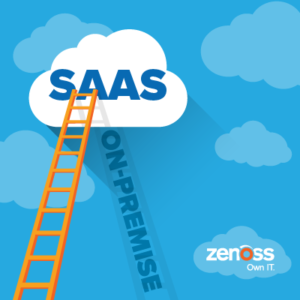
Even though the first SaaS-based (not then cloud-based) IT operations products were available almost 20 years ago, most IT operations management (ITOM) tools are still installed on-premise. Due to scale, security, depleted staffing and feature envy, the last holdouts are starting to come around. Telcos, financial institutions and other risk-adverse enterprise IT shops are starting see past their outdated on-premises-only paradigms.
The changing definition of “on-premise”
With private cloud, mixed public cloud and classic on-premise data centers combining to deliver business services, the definition of “on-premises” is dubious at best. Today, “on-premises” seems to mean an organization's perceived control perimeter, where the infrastructure is actually touchable.
Control perimeters exist within every organization, and inertia maintains these imaginary boundaries until they become too expensive or are proven unreliable. Digital transformation is causing all organizations to weigh the cost/reliability equation in ways that invert the question from “Should we use cloud for x?” to “Why would we not use cloud for x?”
On-premises gives us only an illusion of control in a world where we don’t think we can have control or security if we can’t touch it. In reality, when we expand the control perimeter for ITOM applications into areas already managed by the applications themselves, we get a much higher return on investment.
Security delusion
Security continues to be the on-going (but weakening) argument against running enterprise ITOM applications in the cloud. This way of thinking is often heavily influenced by outdated regulations and corporate policies.
Many pro-cloud experts have pointed at the Equifax breach as another on-premise debacle, and the root issue stemmed from security processes not being followed for an internally managed application. Despite this, many IT operations organizations still insist that ITOM applications are more secure when managed on-premises, even though they are only infrequently updated and scanned for security.
Cloud-based enterprise applications use constant penetration testing and security updates, not to mention general SOC 2 compliance to adhere to security processes and controls. These various security measures allow SaaS-based applications to stay ahead of the game by proactively updating third party libraries and by applying security updates almost immediately upon discovery. That rarely happens with an enterprise on-premises application.
Extended team
If there’s one thing every IT operations team has in common, it’s a lack of staffing, made worse by corporate chiefs asking the team to do more with less in every quarter.
Oddly, CIOs continue to burden their already stretched teams with the job of trying to self-manage the systems management tools that are responsible for ensuring continuity of critical business services. As the global IT infrastructure expands exponentially, so does the size and complexity of the management tools. This “tool bloat” can effect either the number or size of the tools. In addition, these tools often become stagnant with customizations and a “don’t-touch-a-working-system” mentality, especially as staffing changes occur with the operations team.
In the cloud-based version of an enterprise application, a dedicated operations team is leveraging consolidated experiences across a large customer base, and a full-blown development team is continually adding features, improving security and keeping the system up to date with fixes before the end user experiences problems.
Centralized intelligence
While the more obvious advantages of running IT management tools in the cloud are reason enough to consider expiring stagnant on-prem systems, the most compelling reason to convert is to leverage the vast potential of sophisticated IT operations via machine-learned (ML) intelligence, which an on-prem solution can never obtain. Experiences gained by combing over 10’s or 100’s of data center environments result in dynamic management algorithms (AIOps) which are changing in real-time. These ML-based algorithms are constrained in ways to avoid surprise outcomes; however, the benefits of combined analytics become a necessity in the cases of IoT scale, threat impact, complex global infrastructure, etc.
Ultimately, scale and security will drive IT operations towards solutions that can handle the increased infrastructure sprawl for which they are being asked to manage. Zenoss continues to see exponential growth in its ZaaS offerings, where deep infrastructure is managed alongside multi-cloud infrastructure. While Zenoss continues to provide a robust on-prem ITOM solution as well as a cloud-based offering, IT operations teams are continuing to move past old paradigms and take advantage of cloud-based tools as a step towards software-defined IT operations (SDITO), where the fully automated data center will soon be realized.









